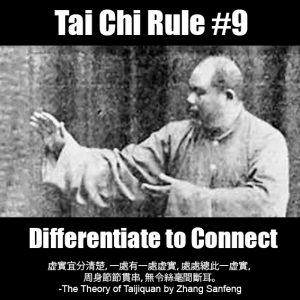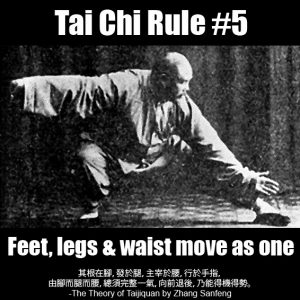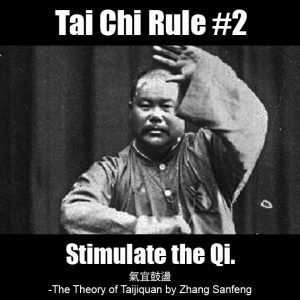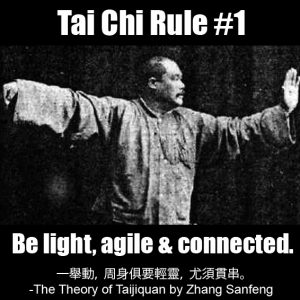Peng is the most fundamental skill in Taijiquan. It’s a prerequisite for every other skill and it’s qualities should be present all the time.
What is Peng?
Peng is the physical conditioning of Taijiquan. It’s the strength & fluidity that comes from doing the hard physical work and building a Taiji body. The “Song of Peng” describes the results of this type of training. In this article we’ll break down each aspect of peng in detail. Then over the next few months we’ll add a bunch of exercises to each section so that you can begin doing the hard work to build this quality.
The Song of Peng.
Peng is like water buoying a moving boat.
First one must sink Qi to the Dan Tien,
Then set the head upright as if suspended from above.
The Whole body should be full of elastic energy,
Opening and closing in just one moment.
Even if there is a thousand pounds of force,
It is easy to float without difficulty.
Like water supporting a moving boat.
When we make contact with the opponent we must be like water supporting a moving boat. There is no space between the water and the boat. The water has a lot of potential power that could effect the boat and yet the boat can enter the water and move freely throughout.
When the opponent moves into our space we must adhere to them. Like the water, we accept them into our space and fill in any gaps between us and them. We do not compromise our ability to deliver power and we do not impede their movement.
This requires a very supple body. We must train our core, hips, and shoulders to flow and move independently of each other. We must remove stiffness from our body and strengthen the weak areas that create tension.
- Shoulder Roll & Shift – for loosening the shoulders and waist
Sink the qi & suspend the head
Sinking the qi is critical in allowing your upper body to loosen enough for good peng.
- Breathe in, raise and expand the chest & back
- Relax and breathe out. Feel the sinking and settling down through your body as you do this.
Repeat this exercise until you are comfortable with this sinking sensation throughout the body. Practice until you can let go and sink quickly without relying on the breath to help you feel it. Keep practicing until this relaxed sunk state becomes a habit.
Leg Strength
As you relax and let go, your weight settles downward and the pressure on your legs increases. Your legs will tense to support the additional pressure and that tension will try to creep back up into your hips, waist, and lower back.
To have peng we must build enough leg strength that our lower body stays relaxed as we sink. Especially when we are in low stances like snake creeps down or when we must stand on one leg.
Suspend the Head
Extend upwards through the spine and out the top of the head. The trick is to keep your mental focus on sinking downwards while pushing up.
Imagine there is a string coming from the top of the spine. So as you sink the head is supported by the string. You should feel the soft tissues and the joints stretch slightly between the downward pull of gravity & the upward support of the string.
Use this imagery to help you extend the spine upward while keeping your mental focus on sinking downward.
The body is filled with springlike energy, opening and closing in an instant.
This is described as being inflated like a rubber ball, springy like a coiled spring, and like a bow that is bent and released.
To build this quality we strengthen our connective tissues by stretching, extending, and twisting them.
Opening is expanding and stretching. Closing is squeezing and contracting.
Strengthening the connective tissues allows us to open and close quickly and fluidly. Opening and closing is also a good way to strengthen the body and build the elastic quality.
Float without difficulty
By strengthening the body with peng we become very strong, relaxed, and fluid. This becomes our natural state so that no matter how much ferocity an opponent brings to us, we continue to flow with ease. And no matter how much pressure we are placed under we adapt calmly and quickly as needed.








